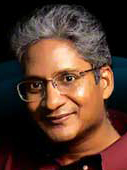The Sankaran Method
 The Sankaran Method is a new deeper approach in classical homoeopathy. The motivation was find a method which would consdr_rajan_sankaranistently yield to a reliable prescription of a deep acting constitutional remedy.
The Sankaran Method is a new deeper approach in classical homoeopathy. The motivation was find a method which would consdr_rajan_sankaranistently yield to a reliable prescription of a deep acting constitutional remedy.
Rajan San karan, Mumbai is a classical homoeopath in 2nd generation; his father was already a well known homoeopath in India .
In over 25 years or research and intensive clinical experience the quest for “How to develop homoeopathy into a consistent healing modality” found an answer:
This new method, also called “sensation method” was presented in the year 2000 and got refined and further made effective since then. This interview with him in 2010 is really good: just klick on video
The majo r elements of the “Sensation Method” are:
New casetaking:
Casetaking developed now into a self initiated introspection of the patient, a journey into his inner world, a tracing of his own associative red thread. Sessions conducted in this manner show many times immediate healing effects lasting a few days.
In order to assist this introspection different techniques have been developed, e.g. description of body sensations, open questions, reflection of words the patient uses with intensity, working with hand gestures and the doodle.
This v ery different and – in a way – therapeutic approach demands from the practitioner a still mind, a keen sense of observation, openness for phenomena different then his own patterns of perception, high level concentration for at least 2 hours and the ability to step back and just listen. Most important it demands to trust that every human being is able to pursue this introspection and that this process will lead – directly or indirectly- to the “Simillimum” – the constitutional remedy.
Systematic Analysis:
The richness and immense diversity of the cases can lead to the Simillimum successfully only with a very systematic analysis. Dr. Sankaran researched very scientifically for 20 years the themes of the three different natural kingdoms – minerals, plants and animals – from which the remedies are derived. Their communalities and differentiation were extracted with the help of search programs browsing through the body of homoeopathic knowledge collected over 250 years. After systematizing of mineral, plant and animal remedies this proceeded into classification of subgroups:
the themes of 32 plant families, e.g. Solanaceae, Cactaceae etc.
of the animal subgroups, e.g. mammals, reptiles, insects etc.
of minerals, e.g., the rows of the periodic table, the columns, the acids etc.
And the themes of nosodes, sarcodes, imponderabilia as well have been well discerned by now.
This work is going on continuously, e.g. in the group of molluscs the differentiation of bivalvia, gastropods and cephalopods was derived according to zoological information and the body of homoeopathic knowledge – provings and clini cal experience.
Since 2009 I combine in my seminars teaching of Materia Medica and case taking techniques with specially selected perception training in what I call “interactive teaching” in order to enable the homoeopath to accompany the introspective processes.
More reference material about this method can be found under books, DVDs, magazines and on the website of Dr. Sankaran www.rajansankaran.com , e.g. he offers a weekly online course.An important support in my work with the Sankaran Method is Sankaran’s software “Vital Quest”. It contains a module for case analysis and a great amount of information on themes of kingdoms and subgroups which will be published as books only a few years from now.
Vital Quest can be ordered via www.rajansankaran.com .